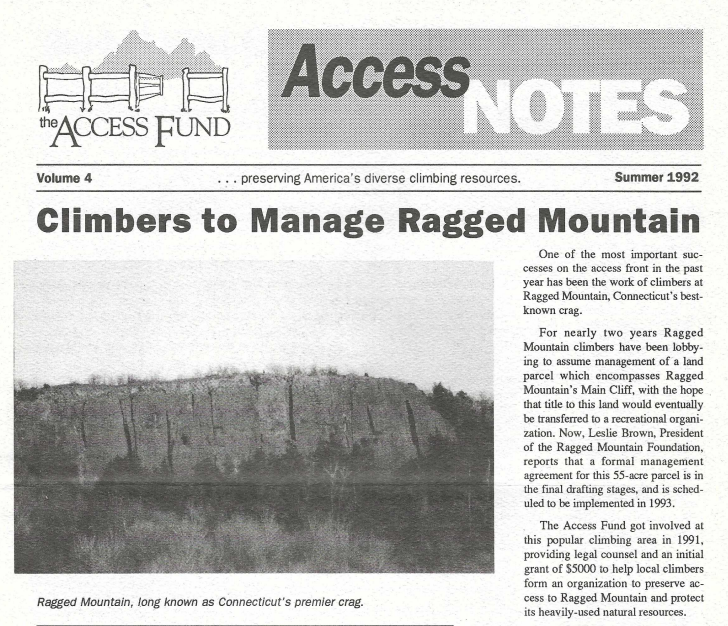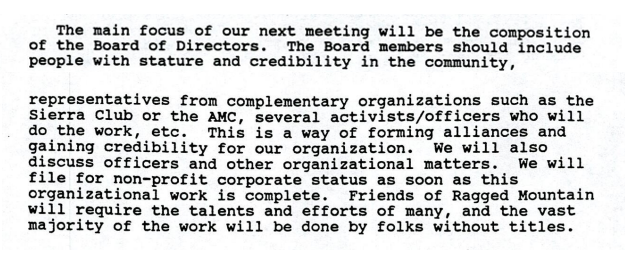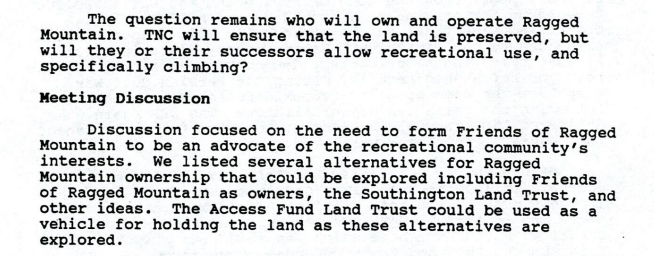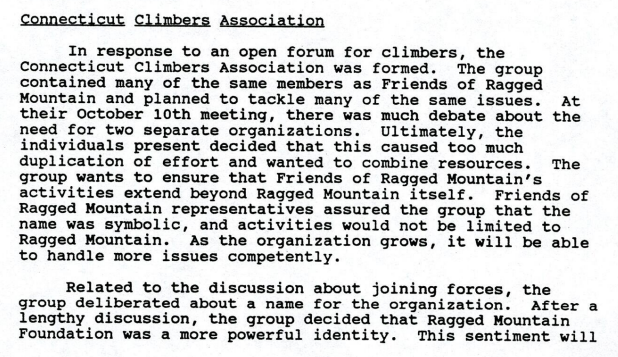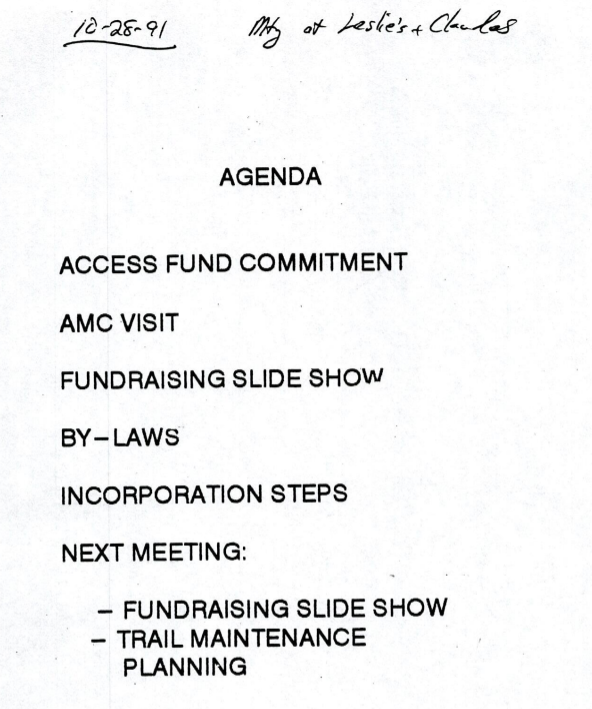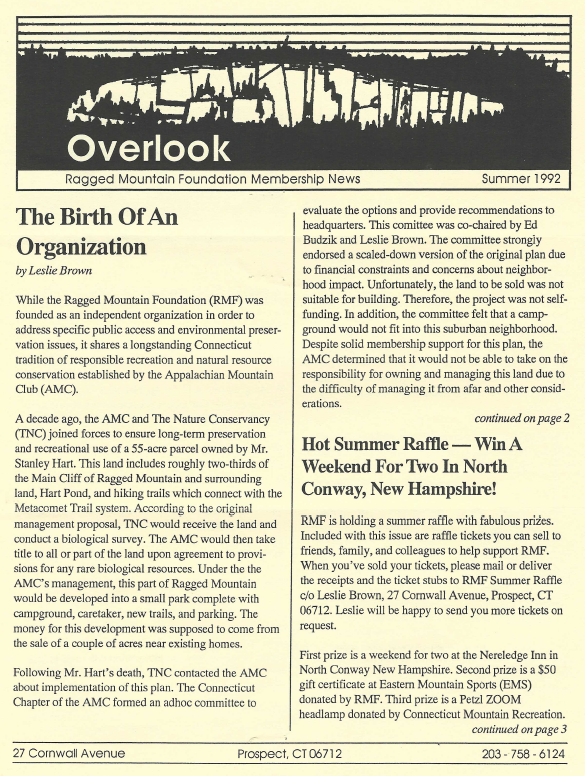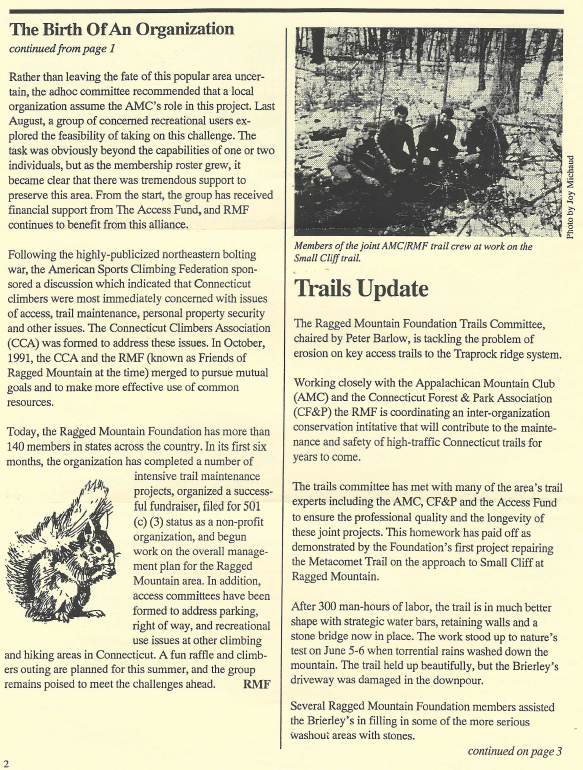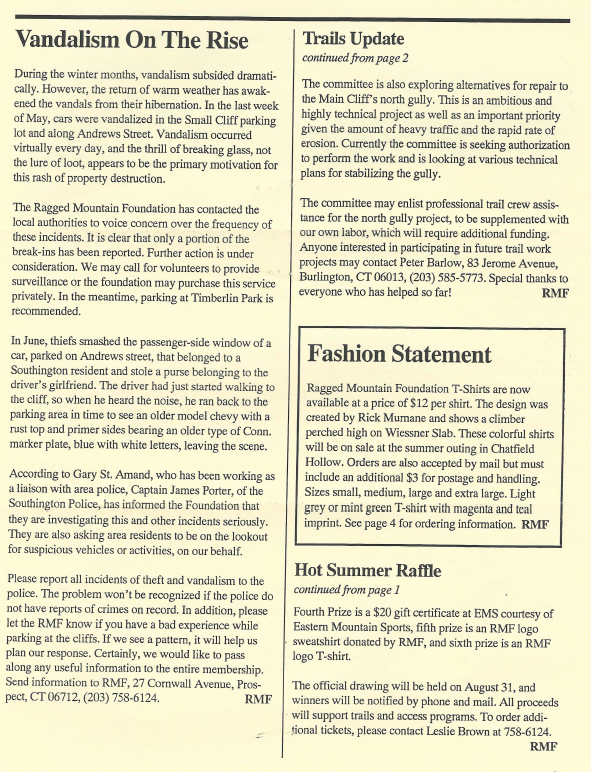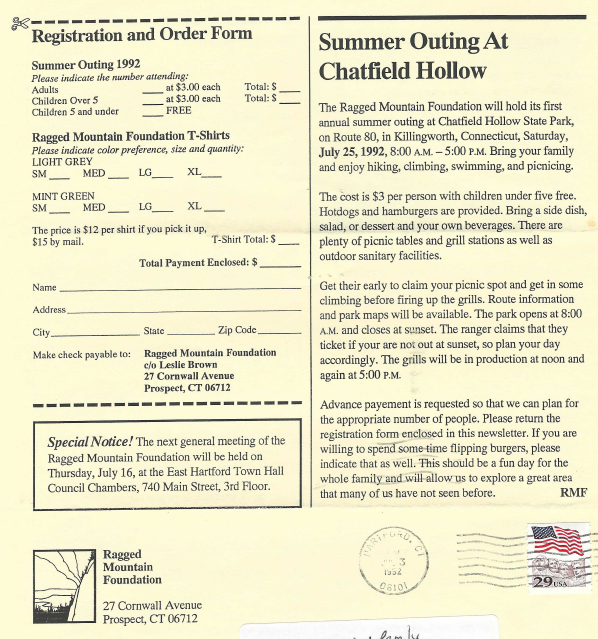Where It All Began: A Conversation with Leslie Brown
I have had the pleasure of volunteering for the Ragged Mountain Foundation for six years. I joined the Board of Directors in January of 2018, after having been invited by my dear friend, and fellow director, Anne Parmenter. In my time with the RMF, I’ve had the opportunity to serve as Vice President, to support our Communications and Marketing Committee, and work alongside and get to know some really amazing people and incredible climbers. I now find myself taking stock of our work and looking back at where we came from to better support where we are going.
The beginnings of the Ragged Mountain Foundation are in the formation of a group of climbers and conservationists who called themselves Friends of Ragged Mountain. Led by Leslie Brown (founding member of the RMF), conversations about how to maintain recreational use of the land we call Ragged Mountain (The Main Cliff), began after Stanley Hart passed away in 1989. After the American Mountain Club (AMC) declined to take ownership of the property, The Nature Conservancy stepped in.* In November 1990 the Access Fund, a fledgling organization started by the American Alpine Club, got involved to help the Friends of Ragged Mountain negotiate land management of the Main Cliff property.
It is said that The Ragged Mountain, Main Cliff management might even be one of the first projects that the Access Fund took on. Diving through the Acquisition History on the Access Fund’s website, we find Ragged Mountain, Southington, CT listed as 1992, preceded by Unaweep Canyon in Colorado, 1991 and Peshastin Pinnacles, Washington, 1990.
To find out more about the history, I reached out to Leslie Brown to understand what took place all those years ago.
“We were the first real acquisition,” Brown says of the RMF/Access Fund partnership.
Leslie Brown
Recent photo taken on Mount Thielsen in Oregon. Photo by Rita Hansen.
I asked Brown how she knew to reach out to the Access Fund back in 1989. Brown said that the Access Fund had run an article in Climbing Magazine saying they could help with various types of projects.
“I had just gotten a parking ticket for parking where I had been parking for a year and a half to go climbing. I was incensed about that. I called the Access Fund. I wanted them to help us with a parking lot somewhere.” After contacting the Access Fund to apply for a grant, Brown brought together a few key people in the climbing community to energize the movement for a parking lot. This is when she learned from the Connecticut Mountaineering chapter of the AMC that there had been plans for Ragged Mountain to become an AMC property, “with a caretaker’s house, campground and nature trails.” Brown decided to turn the parking lot project into land acquisition.
“In the west,” Brown began, “climbing is very accepted. Trailhead parking is accepted, cliffs and mountains are considered assets to the community, as opposed to hidden gems.” Brown explained that the whole concept of owning the land came from watching what was happening around the country unless climbers owned the cliffs. Access to climbing on public land was at the whim of the appointed or hired public servants, like superintendents, the Forest Service, mayors and town planners. “It became clear that if you really wanted to be able to climb, to have climbers determine their destiny, then we needed to own the cliff.” So Brown and Friends of Ragged Mountain got to work securing a grant and building energy around turning Ragged into a climber-owned crag.
RMF Archives
An excerpt from an article published by the Access Fund in Summer of 1992, celebrating the planned acquisition of Ragged Mountain by the Ragged Mountain Foundation.
This process involved building the organization we now know as the Ragged Mountain Foundation. “We thought very strategically when we set up the board about ‘what skills did we need?’ With that first board, we specifically tapped people with connections to CFPA, people with legal skills. We looked for who’s got financial skills, who’s got PR skills. Every member of that board brought very specific skills and connections that we needed to be successful.” They also held meetings with Southington Town Council to convince them that the organization was made up of “a legitimate group of real people with regular lives, who were well-educated, high-earning members of the community.”
RMF Archives
An excerpt from Friends of Ragged Mountain Meeting Minutes in August 1991, where discussions about formation of a Board of Directors were held.
On October 8, 1991, Friends of Ragged Mountain met to discuss the following: AMC’s plan to support a partnership between the aforementioned and The Nature Conservancy, an update on the Access Fund’s plan to vote on a financial commitment of $5,000 to support the Ragged Mountain Project, meetings with Southington Town Officials to maintain public access to Ragged Mountain and the formation of the Ragged Mountain Foundation by combining members of Friends of Ragged Mountain and the Connecticut Climbers Association.**
On October 28, 1991, the first official meeting of the Ragged Mountain Foundation was held.
RMF Archives, excerpts from Friends of Ragged Mountain Meeting Minutes and first official meeting agenda, October 1991.
Fast forward a couple decades to 2019. Matt Conroy, then RMF President, was meticulously scanning page after page of documents, meeting minutes, articles and so on from the 90s to preserve our history. I thumbed through some of the binders, not really consuming what was in front of me at the time. After six years with this organization, seeing board members come and go, leadership change, membership grow to numbers we haven’t ever seen and drives for advocacy and access with Hanging Mountain and Bradley Boulders, I find myself thinking back to that group of folks in the 80s and 90s and feeling grateful for the work they started. Grateful for the proof of that work in the archives.
They were so hellbent on maintaining access to a suburban crag on a beautiful piece of property and hoping to build an organization that would eventually turn its eye toward broader climbing access across the state and region. A misty-eyed Brown said “We really wanted that crag as our cornerstone, but we didn’t want to be this mass of Connecticut climbers all huddled up against one cliff. We wanted to be able to climb all the little crags, to have them all protected. And I think that’s still true.”
She goes on to recall “It was a really special time, a really frustrating time, a really rewarding time. I was a new person coming along. I was not a very talented climber, but I enjoyed it. I did not understand the faith, or the folly, of the Access Fund and other climbers in Connecticut allowing me to take on the role I took at that time…But I love the brotherhood of the rope and that trust in each other. And we all had a part to play, it took every one of us. It took the leader and the belayer to make this thing happen.”
RMF Archives of Overlook Newsletter, Summer 1992
And, in fact, here we are, more than 30 years later, still engaging in the fight, still holding space for recreational access, advocating for our community with DEEP, building a movement for access to Bradley Boulders, partnering with towns like Meriden to legalize climbing on public land. All of this is thanks to those early advocates, those dreamers. We were born as Friends of Ragged Mountain and we live as the Ragged Mountain Foundation. We were built by climbers and conservationists and activists. We are supported by our member community. We are led by volunteers who are teachers, coaches, financial advisors, retail workers and more. And we continue the work of the Friends of Ragged Mountain today, tomorrow and beyond. The RMF, its Board and members hold a well of gratitude for our founders: For your dreams, tenacity, and relentless advocacy, we thank you. We could not have come this far without you.
To support our efforts, consider becoming a member of the Ragged Mountain Foundation. Information about our membership tiers and benefits can be found here.
A Little About Leslie Brown:
Leslie grew up as a feral child in Prospect, Connecticut. She graduated from Yale University with a BA in Administrative Sciences and from Rensselear Polytechnic Institute with an MBA in Finance and Policy. She worked for Southern New England Telephone, holding a variety of positions in Treasury, Accounting, Finance, and Strategic Planning. Lessons in building new organizations were gained from participation in the early days of the cellular phone industry as VP - Finance for SNET Mobility. Nights and weekends were spent running, skiing and climbing. Passion for the great outdoors led Leslie and her husband, Claude, to guiding for Eastern Mountain Sports and Ski instruction at Mohawk Mountain.
After SNET was purchased by Southwest Bell, Leslie moved out West to work in the competitive internet backbone industry and then set 13 years in the alternative energy industry. As part of Avangrid Renewables, the team built the second largest producer of green energy in the United States and the world. Outside and out-of-the-office, guiding opportunities nearby were sparse. The local Mountain Rescue Team was headquartered close to their home, enticing Claude and Leslie to build the rope rescue program for their rescue team. They have served as examiners for team accreditation for the Washington Mountain Rescue Association. Climbing, mountaineering, kayaking, biking, hiking, skiing and rescue keep them busy. Leslie continues to be active for the Access Fund.


